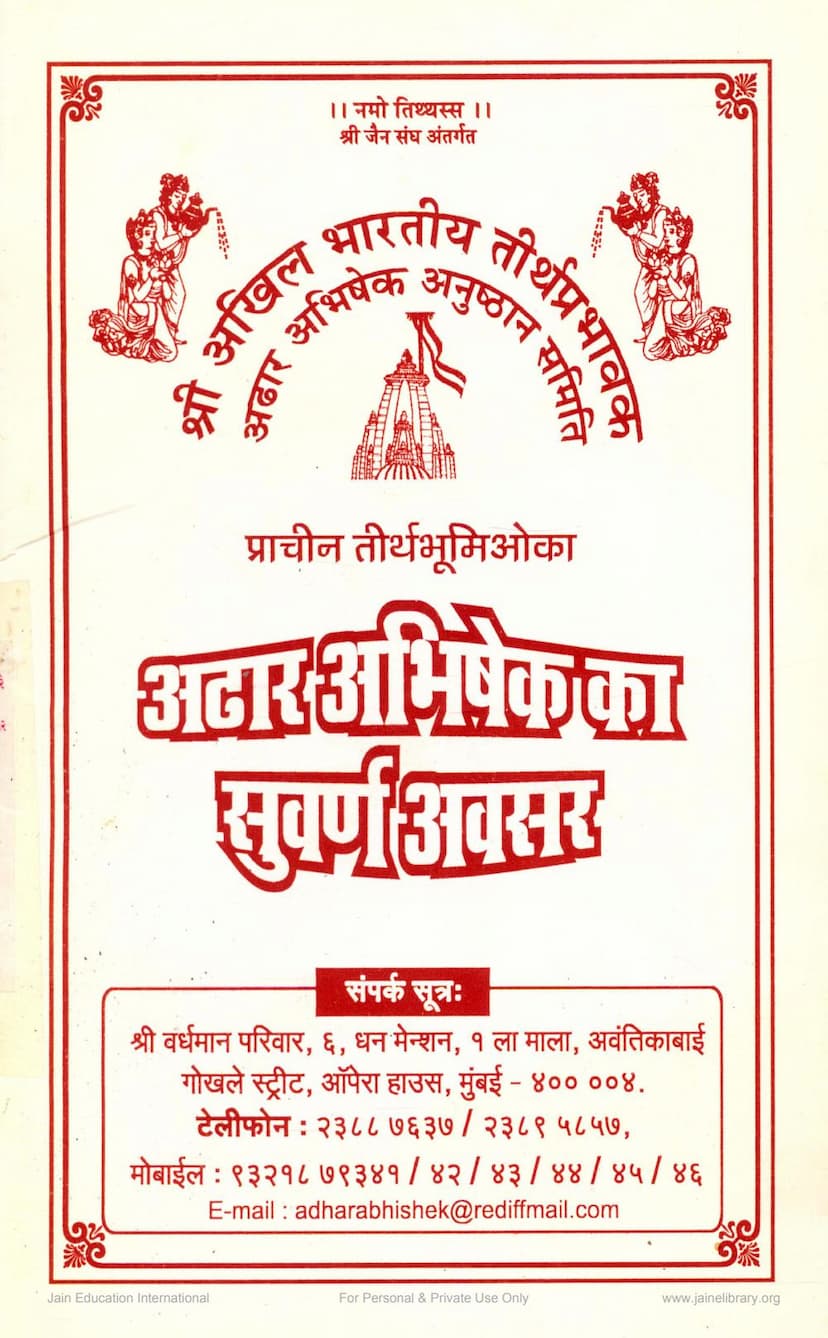Adhar Abhishek Ka Suvarna Avasar
Added to library: September 1, 2025

Summary
This document, "Adhar Abhishek ka Suvarna Avasar" (A Golden Opportunity for Abhishek), published by the Akhil Bharatiya Tirthprabhavak Adhar Abhishek Anushthan Samiti, is a detailed guide on performing an "Athara Abhishek" (Eighteen Abhisheks) in Jainism.
The text begins by explaining the significance of Abhishek, drawing a parallel to the birth of a Tirthankar. It states that while the Tirthankaras themselves are pure, Abhishek is performed to purify any unintentional disrespect or "ashatna" that might have occurred towards the divine idol in the temple. This purification is achieved through the use of specific sacred substances and the chanting of mantras.
The document then meticulously outlines the procedure for the Abhisheks, detailing the materials to be used for each of the eighteen stages. Each Abhishek is characterized by a unique mixture of ingredients, often involving medicinal herbs, precious metals, auspicious items, and water from sacred pilgrimage sites. The process emphasizes the importance of purity, devotion, and the correct pronunciation of mantras.
Key elements described include:
- The Purpose of Abhishek: To purify any unintentional disrespect to the divine idol and to receive blessings.
- The Ingredients: A wide array of sacred materials are used, including:
- Golden powder
- Five-gem powder (pearl, gold, silver, coral, copper)
- Astringent powders from various tree barks
- Sacred earth from different locations
- Panchamrita (milk, curd, ghee, sugar, honey) or Panchagavya (cow products)
- Medicinal herbs (various roots, leaves, barks)
- Aromatic substances
- Flower extracts
- Saffron and musk
- Camphor
- Water from pilgrimage sites
- The Rituals:
- Kusumanjali: Offering flowers with devotion before each Abhishek.
- Stuti/Slokas: Recitation of prayers and verses dedicated to the Tirthankaras.
- Mantra Chanting: Specific mantras are provided for each Abhishek, invoking divine blessings.
- Offerings: Following each Abhishek, various offerings like lamp (deep), unbroken rice (akshat), food (naivedya), and fruits are made.
- Chandan Puja, Pushpa Puja, Dhupa Puja: Specific pujas using sandalwood, flowers, and incense are performed.
- Mudras: Specific hand gestures (Garuda Mudra, Mukta Shukti Mudra, Parameshti Mudra) are described for invoking the divine presence.
- Chandra Darshan and Surya Darshan: Special rituals involving symbolic representations of the moon and sun are included.
- Aarti and Mangal Deep: The ritual of waving lamps to a divine rhythm.
- Laun Utarna: A purification ritual using salt and earth.
- Shanti Path: Chanting of peace prayers.
- Ashtaprakari Puja: The eight types of worship.
- Guru Abhishek: A separate section details the five Abhisheks for the Guru's image.
- Devi Abhishek: Five Abhisheks for the Goddesses are also described.
- Emphasis on Purity and Devotion: The text repeatedly stresses the importance of cleanliness, purity of mind, and sincere devotion throughout the entire process. Participants are advised to wear clean clothes and maintain a reverent attitude.
- Community Aspect: Performing the Abhishek in a community setting is highlighted as beneficial, fostering collective joy and shared spiritual experience.
The document serves as a comprehensive manual for individuals and communities wishing to conduct this elaborate Jain ritual, ensuring that each step is performed with the correct procedures and intentions for spiritual merit and divine blessings. It is presented as an opportunity to connect with the divine and purify oneself from karmic impurities.